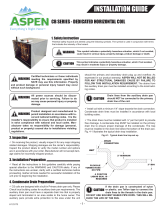
5
couplingassemblies(Figure5).NOTE: The amount of oil
usedmustcoveralldesignatedsurfacessufciently.
6.While holding the coupling halves in proper alignment
with each other, start twisting the threads of the
female coupling nut onto the male coupling assembly.
NOTE:Thecouplingendfacesshouldbeparallelwitheach
otherandvisuallyinline;thisallowsthefemalecoupling
nut(Figure6)tobeeasilyhandthreadedfortheinitial2-3
rotations.Theseinitialrotationswillbringthediaphragms
intocontactandasharpincreaseintorquewillbefelt.
IMPORTANT: If the nut will not start by hand, adjust
the position of the line set to ensure proper coupling
alignement and eliminate/minimize all side load force
on the coupling during assembly.
7.Usingappropriatelysizedwrenches(seeTable2,page
6)forbothcomponents,tightenthefemalecouplingnut
whilepreventingrotationofthefemalebodywithrespect
to the male coupling.
IMPORTANT: The nut should be tightened until a definite
increase in resistance is felt. At this point, the nut will
have covered most of the threads on the male body. It
is important to ensure the male and female coupling
bodies DO NOT rotate during any portion of the wrench
installation.
8.Usingapermanentmarkerorscribe,markalinelengthwise
fromthefemalecouplingnuttothefemalecouplingbody.
9.Tightenanadditionalwrenchat(60°).Refertothemarking
onthecoupling nuttoconrmtheone wrench at has
occurred. NOTE:This nal wrench at is necessary to
ensuretheformationofthemetaltometalleak-proofseal,
betweenthemaleandfemalecouplings.
10.ProceedtoCompleting the Installation section.
Quick Connect 2
Thisprocedurecanbe used if there isenoughroomand
lineset length to connect the lineset directly to the coil and
eliminatetheneedforthequickconnects.
1.Verifythatthereissufcientlengthoflinesettoreachthe
coil.Allowforappropriateandadequatebendradius.
2.Verify that there is sufcient room for the tubing when
appropriate radii are added to the lineset.
3.Cuttheexistingquickconnectendsfromthelineset.
4.IfTXVkitandnewliquidlinearebeinginstalled,skipto
step7.
5.Iforiginalliquidlineisbeingused,relieveallpressurefrom
thecoilbydepressingthevalveontheliquidline.Remove
thevalvecore.
6.Usingallappropriatecautions,unbrazeandremovethe
valveholderontheliquidline.
7.Connectthesuctionandliquidlinesettubes.
CAUTION:
It is recommended that a wet rag be wrapped
around the suction line in front of the close
off plate before applying heat. Failure to keep
components cool during brazing may result
in structural damage, premature equipment
failure, or possible personal injury.
8.Brazetheindividualconnectionswithdrynitrogenowing
through the joints.
IMPORTANT: To prevent internal oxidation and scaling
from occuring, braze all connections with dry nitrogen
owingthroughthejoints.
9.Wraptherefrigerantlineswithpressuresensitiveneoprene
orothersuitablematerialespeciallywherethelinesenter
the opening in the sheet metal.
10.ProceedtoCompleting the Installation section.
Downturn
1.Determinetheappropriateconnectionkitbyreferringto
Table1(page6).
2.Cutoff2.5inchesoffthecoilsuctionandliquidlinetubes.
DO NOT swage the cut ends.
3.Connectkitpartstocoil.
CAUTION:
It is recommended that a wet rag be wrapped
around the suction line in front of the close
off plate before applying heat. Failure to keep
components cool during brazing may result
in structural damage, premature equipment
failure, or possible personal injury.
4.Brazetheindividualconnectionswithdrynitrogenowing
through the joints.
IMPORTANT: To prevent internal oxidation and scaling
from occuring, braze all connections with dry nitrogen
owingthroughthejoints.
5.Connectthesuctionandliquidlinesettubes.
6.Brazetheindividualconnectionswithdrynitrogenowing
through the joints.
7.ProceedtoCompleting the Installation section.
Completing the Installation
1.Checkthesystemforleaks,includingthelinesetandthe
brazedjoints.
NOTES
• Applyasoapandwatersolutiononeachjointorunion
with a small paintbrush. If bubbling is observed, the
connectionisnotadequatelysealed.
• When installed in the horizontal right position, it is
necessarytoapplyinsulationtothesuctiontube.Without
the insulation, water management issues may arise.
2.Evacuatethesystemofmoistureandnon-condensables
topreventlowefciencyoperationordamagetotheunit.
Thesuggestedrangeofevacuationis250-500microns.
3.Chargethesystemwithrefrigerant.
IMPORTANT: The amount of refrigerant necessary with
a microchannel evaporator will typically be different
than the amount designated on the condenser’s rating
label. Use either the superheat or subcooling method
(depending on the metering device used) to properly
charge the system. Refer to the condenser unit’s
documentation to determine the amount of superheat
(typically a minimum of 5° F) or subcooling (typically
between 8° F & 12° F).
4.Installthecoilaccessdoor(ifremoved).
5.Properlydisposeofallremovedparts.
6.Applypowertotheunit.








